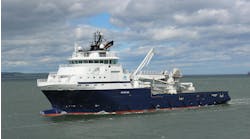Producer facing financing, production challenges
Wang Ming WuChina National Offshore Oil Company's first quarter sales income figures were ¥2,278 million, a ¥394 million decrease from the same period last year. Oil prices fell to US$13/bbl in early July and resulted in a ¥132 million decrease in profits from the same period last year.
Contributing Editor - Beijing
China's offshore oil industry is facing a dramatically changed situation and China National Offshore Oil Company (CNOOC) is confronting two major challenges.
- The State's macroeconomic requirements include maintaining an economic growth rate of 8%, an increase in prices within a range of 3%, and maintaining stablity in the RMB exchange rate.
- The fall in the international oil prices has dealt a blow to CNOOC's management.
Cost analysis
Oil prices are only a temporary condition, but cost management is long term and basic work. Possible losses were analyzed in accordance with present production costs and expenditures. A cost analysis reveals that the difference between the average oil price/bbl sold and the overall cost/bbl paid is only US$0.01-0.02.CNOOC's production cost/bbl is nearly double the Southeast Asian average. Its paid cost/bbl is US$6-7 higher and US$3-4 higher than the Southeast Asia average and the North Sea average, respectively. This is like remaining at home and eating away a whole fortune. An oil enterprise will collapse in only a few years if it does not reduce the production cost/bbl and add the savings to its sustainable development.
The analysis shows that present production is not profitable and is close to loss. It also shows the enormous potential and room for reducing production costs.
Only by working hard with no illusions about future price increases can CNOOC achieve sufficient cost reductions. CNOOC has determined that now is just the right opportunity to stress practical cost management in order to improve overall enterprise management.
Inexorable option
The current reduction of expenses and consumption of raw materials was caused by the Asian financial crisis and the sharp fall in international oil prices. This places offshore oil enterprises in a very difficult situation. Analyzing the the matter, we find there was an objective need to strengthen the risk-resistance capabilities of China's offshore oil development and distribution system.Never before have the varied offshore oil enterprises reached a consensus as they have today. CNOOC has been driven onto an overhanging cliff by the current oil price. From a long-term viewpoint, cost reduction offers offshore oil enterprises the viability and power to survive the low oil-price environment. It is an inexorable option, and of vital importance to offshore success and to the future of the management and workers.
CEOs of regional oil companies are placing themselves in position to take charge of individual oil fields and manage costs. They have been assigned the responsibility to create effective measures "bit by bit" and pay close attention to each item. At a conference held this past summer with senior management, Wang Yen, CEO of CNOOC, said that the tasks must be fulfilled regardless of what must be sacrificed on a personal basis. The thrust of the conference was how to readjust all aspects of the system to maintain output and profits under low oil prices.
The new way
Suggestions for reducing the development cost of engineering projects lies with new ideas, new technologies, new methods, standardization, simplification, and nationalization."Proceeding in all cases from the lowest cost, Bohai is to reach 10 million tons at lower cost," stated Dai Huandong, CNOOC Deputy CEO, who recently visited the Bohai Corporation. He said the goal would be reached by reducing:
- Production cost/bbl (and profits to a certain extent)
- Operational cost by 15%
- Management expenses by 5%
- Base subsidy by 40%
With peak production from Nanhai East Corp (CONHE) over, the Bohai Corporation should become an economic pillar of China's offshore oil. Bohai Corporation has wholly-owned production as its mainstay.
Achieving the 30-million-ton goal will be a breakthrough in CNOOC history, also an excellent growth opportunity for Bohai. But, Bohai can not easily realize 10 million tons by 2003 or 2004 at its present level, due to management. New foreign projects are about to make their appearance.
Reductions in force
The large support organizations must be reduced in size. This will be done by combining structural readjustment in the ranks with reduction in the employment of contract workers. Costs will be lowered by quickly making reforms in the base companies.Support organizations are to be examined to see if their existence is necessary, based on the profit targets set by CNOOC. All organizations that need to be closed must be closed or changed. Reform in the financial system will begin by setting up a chief accountant system and by putting process control into practice.
The readjusted 1998 production targets set by CNOOC are:
- 2.6 million tons from Bohai
- 13.0 million tons from Nanhai East
- 1.0 million tons from Nanhai West.
Hidden savings
CNOOC can now only maintain a small profit, but it has to make an expanded profit, striving for continued existence and development. It has to cut down or put off some projects to do exploration, development, and downstream projects. The company realizes that the 30-million ton goal requires great investment.CNOOC is straining with its available funding - ¥8,000 million in total for exploration and development. Cost savings in Suizhong 36-1 oil field are preliminarily estimated at several hundreds of million yuan. If one field can do that, 20 and more CNOOC fields in or preparing for development, will achieve great cost savings.
The cooperative oil fields in eastern Nanhai were better. There are good prospects for reducing costs. Both CNOOC and its Sino-foreign partners have reached a common understanding.
Oil prices are independent of CNOOC's control, but production must be developed on course. Work toward the 30-million-ton goal must continue, and exploration wells to discover new fields must be drilled. The fundamental path lies in reducing costs.
Copyright 1998 Oil & Gas Journal. All Rights Reserved.


